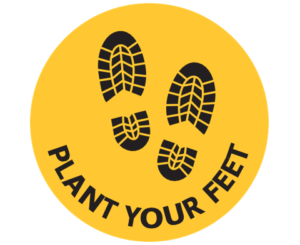The usual approach to reducing slips, trips and falls is to look at housekeeping on a site, to fix leaks, clear up spills, waterless cleaning techniques, coil up hoses, level out changes in floor levels and consider the grip offered by the surface of work areas. Some of these techniques can be applied in offices, fibre supply yards and landscaping sites, but more often, these approaches are not relevant when applied to Tilhill’s outdoor working environment.
So, the question we have is: “How can we reduced slip, trip fall injuries on our forestry and harvesting sites?”.
In the past we have tried to search for the answer to this in near miss reporting. Not reporting every slip or trip, but reporting sites where it is more common, and describing the site. From these reports we produced a series of Guidance Notes and Toolbox Talks. We still would encourage you to report sites where slips and trips are at a high level and to describe the conditions on site and what work is being undertaken. While there may be little we can do in that particular instance, the reports, when reviewed overall, can indicate which conditions make slips and trips more likely.
We cannot simply acknowledge that slips, trips and falls account for the majority of our own staff RIDDOR injuries and not seek to reduce their number, no matter how difficult that seems at the outset. To this end we are launching our ‘Plant Your Feet’ programme, where we will be looking at how we can minimise slips and trips.
Consider:
- Situational Awareness – What is the site like? How much brash is on the ground? How steep is the site? Is the ground uneven? We have found that walking across restock sites can present more risk of slips and trips than new planting sites. This can be worse if the crop was windblown and the ground surface is further disturbed.
- Footwear – Consider what footwear you use. Do they offer good ankle support? What is the sole of the footwear like? ‘Anti-Slip’ shoes often have a close tread pattern that works well on sealed factory floors, but in a forest situation will easily and quickly become clogged. A deep and open tread is more likely to find traction and not become clogged.
- Overgrown Vegetation – This can present two issues. The first is hiding the underlying ground conditions and uneven ground. The second is that it can cause trips as it snags on trousers and laces. Carrying a pole or walking stick can be a great aid to knock vegetation back and test the unseen ground before taking the next step. It can also help knock ticks off vegetation ahead of you.
- Carrying loads – It is inevitable that we have to carry loads across sites, but can it be minimised and done in such a way that it leaves your hands free?
- Crossing Ditches and Drains – A common enough occurrence in forestry, but when is a drain too wide to cross? From the evidence of reports of twisted knees, you should only cross if you can step across a ditch and if not then find a more suitable crossing point. Don’t jump across.
- Winter Working – Whatever footwear we choose, its ability to find grip will be limited in icy wintery conditions. Walkways should be salted and cleared, but where large areas or rural tracks are to be walked use products that stretch over your boots and provide metal studs underneath to bite into the ice.
- Rocks, Roots and Brash – These can become very slippery when wet. Sections of timber in the brash mat that have had the bark removed can be especially slippery. Avoid standing on them and aim for small sections. Softer rubber compounds can help with grip on rocks and roots.
These are some of the ways we can work to try to reduce the number of injuries from slips, trips and falls on our sites.
With such unpredictable conditions under foot, we must always ensure the grip between the sole of our boot and whatever we are about to stand on will be enough. Make sure your foot is well planted before transferring your weight onto it. Remember to always “Plant Your Feet”.




